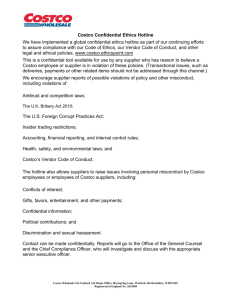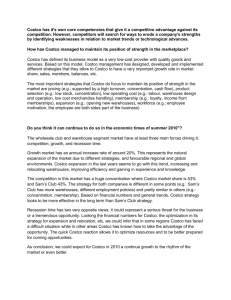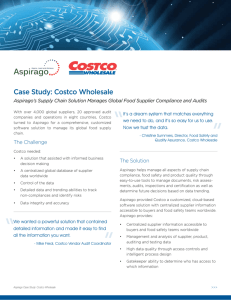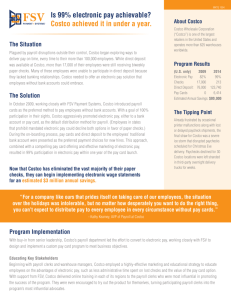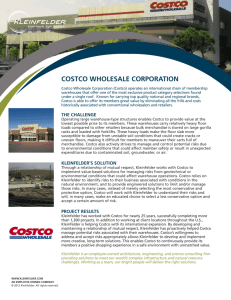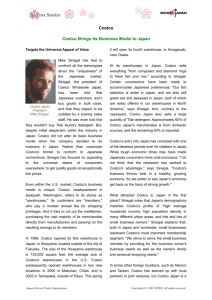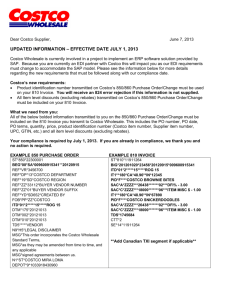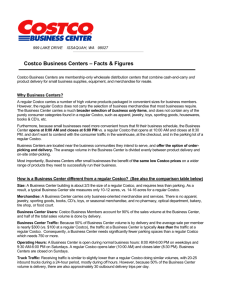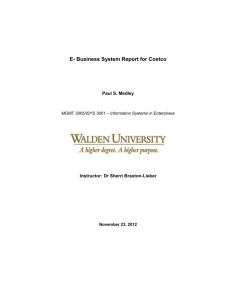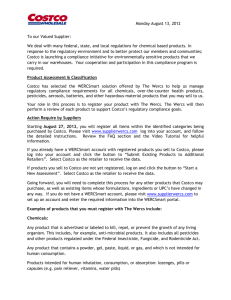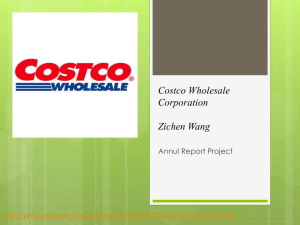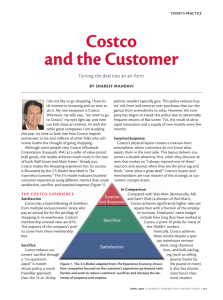*** 1
advertisement
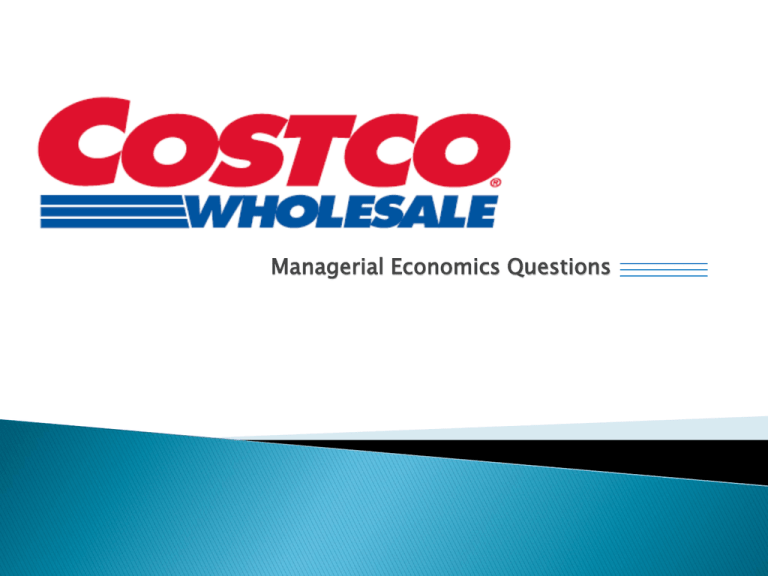
Managerial Economics Questions Organization Kyle Jelinek CEO My Father: Craig Jelinek Kate CFO Jim Supply Chain manager Alexandra Marketing Director I am Nash Economist About Costco • Costco is a Washington corporation, Nasdaq ticker symbol “COST”. • Operates an international chain of membership warehouses, mainly under the "Costco Wholesale" name, that carry quality, brand name merchandise at substantially lower prices than are typically found at conventional wholesale or retail sources. • The warehouses are designed to help small-to-medium-sized businesses reduce costs in purchasing for resale and for everyday business use. (Individuals may also purchase for their personal needs.) Membership Only • Costco is open only to members and offers three types of membership: Business, Gold Star (individual) and the Executive membership. What Do We Sell? Costco's warehouses present one of the largest and most exclusive product category selections to be found under a single roof. Categories include groceries, candy, appliances, television and media, automotive supplies, tires, toys, hardware, sporting goods, jewelry, watches, cameras, books, housewares, apparel, health and beauty aids, tobacco, furniture, office supplies and office equipment. Kirkland Members can also shop for private label Kirkland Signature products, designed to be of equal or better quality than national brands, including juice, cookies, coffee, housewares, luggage, clothing and detergent. Q1: If Costco raises membership fee by 5% (inflation trend), what will be the shifts in the demand curves of these three kinds of shoppers? (Please illustrate it) Type 1: Small business manager – Javier/Ken Liu Background: Ken & Javier co-own a breakfast store near NCCU. Javier Also owns a farm. Income: NT100,000. Frequency: once every 2 weeks. Shop Items: bacon/toast/Ken buys PS3 and muffins for his daughter/Javier buys farming tools Type 2: High income people Kelly / Andrea Background: Andrea and Kelly are neighbors, both their husbands run own company Income: NT300,000 / month Frequency: once per week Shop items: office supplies/cereal/fres h food (premium steak/wine/ designer handbags or jewelry Type 3: Young Generation, Shop in Costco for Fun Background: Jin is a student but actually he is a party animal. Income: NT8,000 pocket money from parents Frequency: once per month Shop items: salty snack/beers/shampoos and lotions (for his girlfriend) Q2: Should Costco change different membership rates in countries with different income levels, to expand its business to broader geographical areas? Two part pricing – soaks up higher quantities of buyers’ surplus. Uniform Pricing combined with indirect Buyers Surplus = Membership segment discrimination. Fee Three types of membership: • Executive Membership – annual 2% reward - US$110 • Business Membership – for managers US$55 • Gold Star Membership – individuals and households - $55 Pay and benefits for workers are high compared to the competition – less workers turnover costs and theft by employees. No advertising – saves them 2% of budget per year for employee pay and benefits. Aim for upscale shoppers, especially small-business owners. CEO’s salary is only US$350,000 - less than 10 percent of many other chief executives. Savings translated into lower prices and higher benefits. CEO Kyle Typical Costco store stocks 4,000 types of items, increasing sales volume per supplier, allowing for better discounts. No item can be marked up by more than 15 percent. Before season sales – buying cheaper from suppliers. Coupons for discounts on common use products – attract more price elastic customers. The treasure hunting shopping experience PRODUCT PRICE • • • • Exclusive items Premium quality Bulk size but easy-to -use package High value/ 100% refund policy 80% of competitors’ EDLP • TARGET MARKET PLACE • • • Warehouse like Ready display on pellets Minimum signage in store PROMOTION • • • • Wallet program Passport coupons End-cap display In-store trials Products: Box Size on the Rise, But SKUs Down 143,500 4,100 143,000 4,000 142,500 Average Club Size (Sq. Ft.) 142,000 3,800 141,500 141,000 3,700 140,500 3,600 140,000 3,500 139,500 3,400 139,000 138,500 2006 2007 2008 2009 2010 2011 2012* Average Club Size (Sq. Ft) 140,000 140,000 142,000 143,000 143,000 143,000 143,000 Average Club SKUs 4,000 4,000 4,000 3,800 3,900 3,600 3,550 *Average of approximately 3,300 to 3,800 active SKUs, as reported by Costco Source: Costco Annual Report (fiscal years ending end of August/beginning of September) 3,300 Average Club SKUs 3,900 Costco never advertises, all promotion occurs through BTL. “It costs a lot of money to make these places look cheap” - Jim Sinegal, Costco co-founder • When a new clubs opens We visit from door to door to recruit new members New members are allowed to get one more free headcount Locals gain awareness through staff recruiting activity, or media reports Costco carried only 4000 SKUs, comparing to avg. 20,000 in other hyper markets, only 1/5 of competitors. Value for money/ Selected items/ exclusive import items/ unique bulk size and packaging Brand doesn’t matter, value is the key!! VALUE FOR MONEY Premium quality Exclusive imports Efficiency & Services Photo printing Pharmacies Optical department Bulk size but smartly packaged goods Exclusive pack size, save by buying bulk volume. It’s all about DISCOUNT!!! ITEM COSTCO Mechanism Wallet promotion Passport program IRC MVM Frequency Maximum 1-2 times / year Price HIGH sensitivity Promotion 6-10 times higher than effect average Minimum in-store decoration & signage Extensive in-store trial OTHER COMPETITOR DM In-store display Trial packs & gifts > 5 times a year Low ??? Earning about twice per capita, well-educated Basket size is around NT. 2000-5000. (in TW) Costco Shopper Unique Shopper contributes business foundation Shopper profile Source: 2010 Nielsen Shopper trend Shopping Behavior 1. Destination category: specialized goods (i.e. fresh meat, drugs , truffles chocolate) or volumetric goods (i.e. family size milk). Salty snacks as impulse category 2. Shopping, than purchasing • Impulse shopping (spend more than expected) • Sampling triggers trial 3. Look for premium & exotic news & willing to try newness 4. Look for value for money 5. Higher basket size ($2,000$5,000) 6. Frequency: once every 3-4 weeks 2012 Costco Financial Performance • • • • Financial Highlights Net sales accounted by major category Gross margin Membership revenue Source: Costco 2012 Annual Report Source: Costco 2012 Annual Report Sundries 22% - candy, snack foods, tobacco, alcoholic and nonalcoholic beverages and cleaning and institutional supplies Food 21%- dry and institutionally packaged foods Ancillary and Other 18% - including gas stations, pharmacy, food court, optical, one-hour photo, hearing aid and travel Source: Costco 2012 Annual Report Gross margin (net sales less merchandise costs) as a percent of net sales decreased in fiscal 2012, largely due to investment in lowering prices, which is consistent with the company goal of maintaining price and value leadership. Source: Costco 2012 Annual Report Two primary types of members: Business $55 and Gold Star $55 (individual) and Business add-on (Executive) $110 2012 Cardholders: Business 6,442 millions. Gold Star 26,736 millions and Executive members which is around 30,000 millions. Member renewal rate was approximately 89.7% in the U.S. and Canada, and approximately 86.4% on a worldwide basis in 2012. Membership fees increased more than 11%, due to the impact of raising annual membership fees in the U.S. and Canada. ◦ strong member renewal rates ◦ good sign-ups at new warehouses ◦ increased penetration of the Executive Membership program Logistics, Distribution, & Supplier Relations • • • • Integration Warehousing & Distribution Inventory Supplier Relations Supplier compliance Minimize material handling Efficient Packaging Display ready PALLETS Timely shares sales data with supplier to replenish inventory Innovative auto-reordering system Minimize the steps of distribution 30% Direct-to-store from vendors 70% Cross docking operations Warehouse design to strip in-store handling cost Economies of Scale & Bargaining Power Visit & work with suppliers to help them to break even or make a profit without raising prices. Knowledge of its suppliers Which group of people belongs to which diagram? THANK YOU!!! ANY QUESTIONS???
